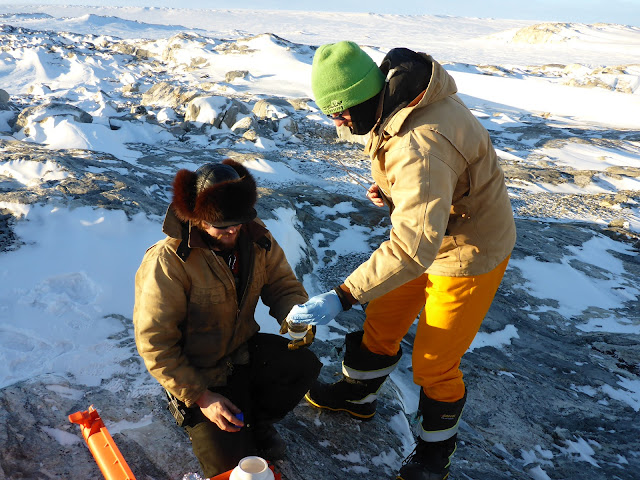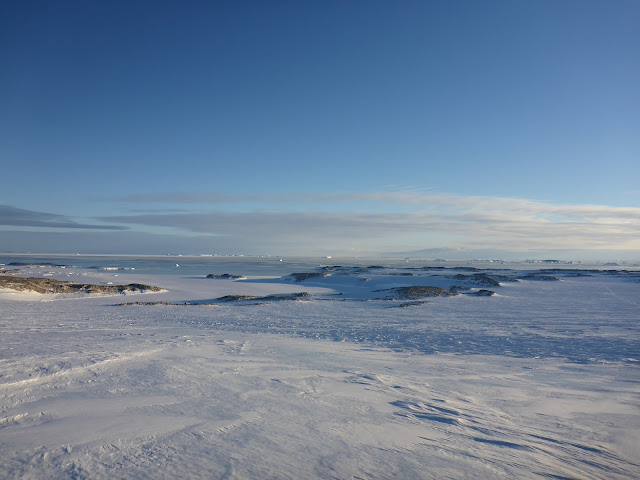Well I thought I'd actually fill in the gaps around the science on this project, after all the purpose for us being down here is to support science. There are no science personnel on station over winter, and any projects with a year round data collection requirement are reliant on training up Station personnel to support their project.
This project is called "Antarctica as a sentinel for Southern Hemisphere Persistent Organic Pollutant Usage; Facilitation of the Global Monitoring Plan".... or as we know it "Bengston-Nash". Supervising Communications Technical Officer Clint Chilcott was selected to monitor the project over winter, clearly impressing the project proponents with his reliable technical demeanor ( having said that this is the same guy that built the igloo that still stands on the heli pad!).
The project is led by Susan Bengston Nash from Griffith University.
Polar regions are environmental 'sinks' for man-made, Persistent Organic Pollutants (POPs). These chemicals are toxic, bioaccumulative and considered a substantial threat. The Stockholm Convention on POPs aims to reduce and ultimately eliminate these chemicals from the environment. Australia has ratified the Convention and holds a legal obligation to conduct continuous, comparable, and high
quality monitoring of POPs within their states and territories. Chemical levels and profiles at the Poles of the earth reflect hemispheric usage and as such are of particular importance and special interest under the Global Monitoring Plan (GMP). The Department of Environment are the lead
agency responsible for fulfilling Australia’s responsibilities under the GMP. This project seeks to provide and safeguard ongoing, streamlined Antarctic access for the purpose of longitudinal monitoring of POP input, distribution, fate in the Antarctic region to serve federal obligations under the GMP.
Whilst this sounds awesomely scientific, our role here at station is just to maintain the passive air samplers out near the old Wilkes station. It pretty much involves swapping out foam filter media which is left in place for 6 week at a time to capture air particles.
The first time I went out sampling with Clint it was a lovely sunny day and not nearly as cold as the second trip. On this occasion it was Clint, Steve "Muscles" Middleton, and I that formed the crack science support team. Muscles and I generally tried to stay out of the way, and opened and closed boxes and jars as directed by our trusty leader!
Clint still has all of his fingers, and we achieved another win supporting science in the Antarctic!
The first time I went out sampling with Clint it was a lovely sunny day and not nearly as cold as the second trip. On this occasion it was Clint, Steve "Muscles" Middleton, and I that formed the crack science support team. Muscles and I generally tried to stay out of the way, and opened and closed boxes and jars as directed by our trusty leader!
Clint still has all of his fingers, and we achieved another win supporting science in the Antarctic!
 |
| Clint supervised by the shadowy assistants. Photo: Jacque Comery |
 |
| Chnaging the battery of the anemometer. Photo: Jacque Comery |
 |
| The anemometer. Photo: Jacque Comery |
 |
| Air sampler. Photo: Jacque Comery |
 |
| Sample media jars ready to deploy. Photo: Jacque Comery |
 |
| Inside the air sampler. Photo: Jacque Comery |
 |
| Clint changing sample media over. Photo: Jacque Comery |
 |
| Jacque getting jars ready for Clint. Photo: Steve Middleton |
 |
| Muscles assisting Clint. Photo: Jacque Comery |
 |
| Clint and Muscles. Job done. Photo: Jacque Comery |
 |
| Clint and Jac all packed up. Photo: Steve Middleton |
 |
| View of Newcomb Bay on the way home. Photo: Jacque Comery |
 |
| Enjoying one of Muscles's yarns on the drive home. Photo: Jacque Comery |